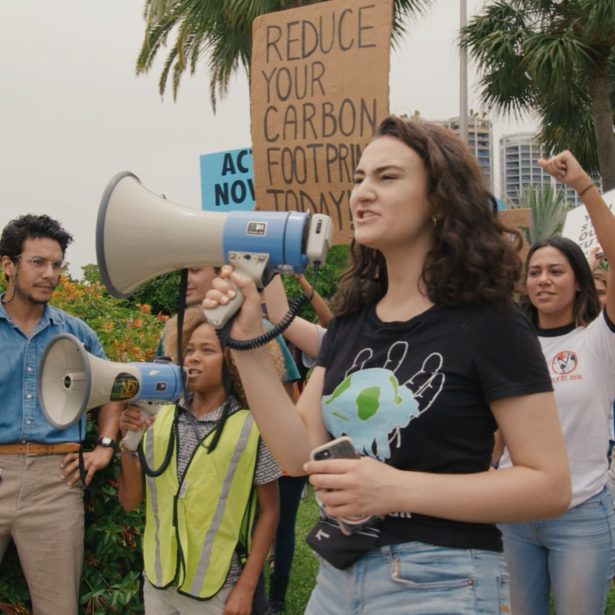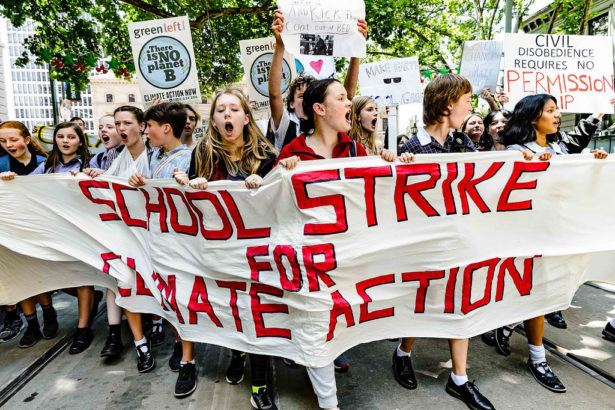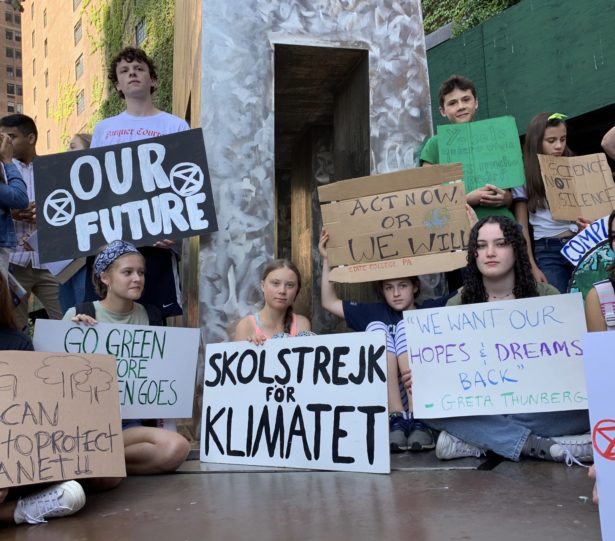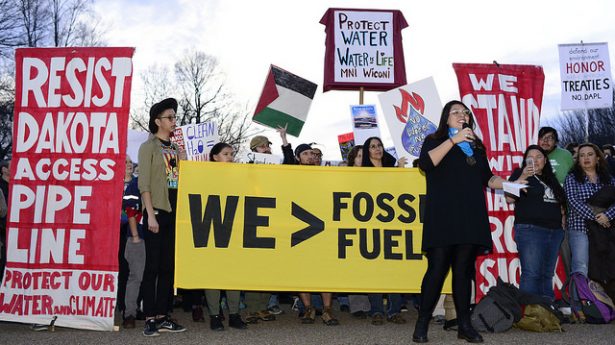It began as a call to action from a group of youth activists scattered across the globe, and soon became what is shaping up to be the largest planet-wide protest for the climate the world has ever seen.
The Global Climate Strike, which kicks off on Sept. 20, will not be the first time people all over the world have taken action for the climate on a single day. But if things play out the way organizers hope, it could mark a turning point for the grassroots resistance to fossil fuels.
“Strikes are happening almost everywhere you can think of,” said Jamie Margolin, a high school student from Seattle who played a role in initiating this global movement. “People are participating in literally every place in the world.”
“Suddenly there’s this entire new generation of activists calling out everyone no matter who they are for not doing enough, and that’s woken people up.”
Starting Friday and continuing throughout the following week, thousands or possibly millions of people will participate in actions calling on governments to address the climate crisis. From elementary school students organizing walk-outs, to experienced activists planning nonviolent disruption in major cities, people will call attention to the moral urgency of climate change by interrupting business as usual.
“It’s a galvanizing moment for the climate movement, which frankly has been losing the battle up to now,” said Jake Woodier of the UK Student Climate Network, which is organizing for the strike in London and other cities across the United Kingdom. “Suddenly there’s this entire new generation of activists calling out everyone no matter who they are for not doing enough, and that’s woken people up.”
As is nearly always the case for large social movements, momentum for the Climate Strike came from many different people in different places. But if its origins can be traced to a specific event, it would probably be a 2018 march spearheaded by the youth-led organization Zero Hour, which Margolin co-founded a year earlier with a small group of other young activists — mainly students of color.
The Zero Hour youth climate march took place on July 21 of last year in Washington, D.C. and was preceded two days earlier by a day of lobbying on Capitol Hill, along with other student-led events all over the United States. Hundreds of young people joined the D.C. action despite rainy weather, drawing considerable media attention and shining a spotlight on how Generation Z is disproportionately impacted by the climate crisis. But what hardly anyone could have guessed was that behind the scenes, Zero Hour had put in motion a series of events that would lead to an even larger, worldwide mobilization led by young people.

On the other side of the Atlantic, Swedish teenager Greta Thunberg, 15 years old at the time, had been reading news about Zero Hour online and was inspired by its leaders’ vision of a distinctively youth-led movement. She began following organizers like Margolin on social media, and soon the teens from different continents were communicating about climate activism over the internet. On August 20, 2018, Thunberg staged her first “climate strike,” skipping school to protest for climate action outside the Swedish parliament. The following month she launched the ongoing “Fridays for Future” strikes, inviting other students to join her in holding school walkouts every week.
“Greta Thunberg’s actions sparked a movement,” Woodier said. “In a world where we’re often made to feel individualized and atomized, that we’re small and can’t make a difference, she has been a massive inspiration to many young people.”
Previous Coverage
 Why desperation could be the key to tackling climate change
Why desperation could be the key to tackling climate changeIn late 2018, Thunberg began attending intergovernmental climate meetings in Europe, including a U.N. summit in Poland. She wasn’t the first young person to show up at the United Nations and call on leaders to take action, but there was something unique about her approach.
For one thing, Thunberg was decidedly more pointed than her predecessors in calling out policymakers’ inaction, telling the leaders in Poland, “You only talk about moving forward with the same bad ideas that got us into this mess. You are not mature enough to tell it like it is.” For thousands of people around the world who were fed up with decades of government inertia, her tone was a welcome change.
Moreover, several converging factors contributed to Thunberg’s activism coming at the perfect time. The climate movement has — over the last decade — been getting gradually better at organizing coordinated actions across continents, making possible the rapid spread of new tactics. At the same time, in the United States, the high school student-led March for Our Lives against gun violence provided a model for what a mass youth movement could look like. Finally, with extreme weather hammering nearly every part of the world, more people are waking up to the urgency of the climate crisis, making them receptive to Thunberg’s message. As a well-spoken member of the generation that will bear the costs of climate change more than any other alive today, Thunberg was the perfect movement spokesperson to harness the opportunity created by these events. Soon her addresses to world leaders were going viral on YouTube.
Meanwhile, the Fridays for Future movement was growing — especially in Europe, where it has had the most influence so far. In July, German Chancellor Angela Merkel cited pressure from youth activists as one reason her government plans to move more aggressively to curb carbon emissions. Across much of Europe, the strike movement has helped put climate change higher on the political agenda for both policymakers and voters. A Green Party surge in May’s E.U. parliamentary elections is possibly the most concrete sign yet of the movement’s impact. But the strikes quickly spread beyond Europe.
There are now nearly 700 strikes scheduled in the United States, and hundreds of others in 117 countries across the globe.
By early 2019, school strikes were taking place in countries including the United States, Brazil, India and Australia. Then, over the spring and summer, calls started coming for a new escalation of the movement — one led by youth, but with participation from people of all ages. The idea was for a worldwide strike where people would leave school, work or other daily tasks to join protests for climate action.
The date chosen to kick off the planet-wide strike coincides with the lead-up to an emergency climate summit, called by U.N. Secretary-Gen. António Guterres and is scheduled to begin in New York on Sept. 23. Many see this U.N. gathering — intended as an opportunity for countries to strengthen their goals under the Paris climate agreement — as being itself a direct reaction to the grassroots pressure governments are feeling.
“This climate action summit was called in response to the worsening climate crisis and pressure from the strike movement,” Woodier said. “That’s a reversal from the past, when climate organizers planned demonstrations in response to official events set in stone long beforehand.”

Thunberg has been invited to address the U.N. meeting, and a special youth summit will be attended by teens from around the world, including Margolin. On Aug. 28, Thunberg arrived in New York after crossing the Atlantic in an emissions-free yacht. She had barely set foot on U.S. soil before joining a youth-led climate protest outside the U.N. headquarters. Meanwhile, the Global Climate Strike has been endorsed by close to 200 organizations in the United States alone, and hundreds more internationally.
While the largest demonstrations will take place in major cities, strike actions are also making waves in smaller towns, even within fossil fuel-producing states. “I expect our growing local climate movement will bring out more people for the strike than we’ve ever seen before,” said Jeff Smith, co-chair of 350 Montana, one of several organization involved in planning a series of strike actions in Missoula. “I expect the crowds alone will be enough to dominate our local news cycle.”
In the United States, national organizations encouraging their members to join the strikes include Greenpeace, the Sierra Club, Sunrise Movement, Oil Change International, MoveOn, Food and Water Watch and many others. According to the international climate group 350.org, there are now nearly 700 strikes scheduled in the United States, and hundreds of others in 117 countries across the globe.
Previous Coverage
 8 lessons for today’s youth-led movements from a decade of youth climate organizing
8 lessons for today’s youth-led movements from a decade of youth climate organizing350.org has a good amount of experience with this type of international climate mobilization. The organization initiated the first truly large-scale day of action specifically devoted to climate change in October 2009. It took place in the lead-up to that year’s U.N. climate negotiations in Copenhagen and was meant to push delegates to adopt a strong, binding international climate treaty. The idea that such a goal could have been successful at that point may appear naïve in hindsight, but at the time it didn’t seem so unreasonable. The United States had recently elected Barack Obama as its president, and even many climate activists had yet to realize just how deeply entrenched fossil fuel money was in the halls of government.
Indeed, the 2009 day of global action was largely a festive, celebratory affair. Groups posed for photos with banners in front of melting alpine glaciers and other landmarks affected by climate change. There was lots of artwork and relatively few truly large marches. This made sense for a global movement that was just finding its feet — at a time when it genuinely seemed like world leaders might be gently prodded into doing the right thing. But with international progress on climate change largely stalled, legislative action in the United States nonexistent, and the ascendancy of right-wing leaders like Donald Trump, the mood of the climate movement has changed dramatically.
“Folks watching the science understand we are now in the runaway phase of climate catastrophe,” said Nadine Bloch, an organizer with #ShutDownDC, which is planning an action to bring work in the U.S. Capitol to a standstill next week. “The urgency of being on fire has finally been heeded by folks outside traditional activist communities.” The Global Climate Strike will take place just 10 years shy of the 2009 mobilization, and it will include larger and more escalated demonstrations. Its message — that action on climate change takes precedence over school and day jobs — reflects this increased urgency.
Yet, while the word “strike” connotes a more militant type of nonviolent action than photo shoots and rallies, not everyone shares the same vision of what it looks like. “In the United States in particular, a lot of people don’t understand what a strike actually is,” Bloch said. “They’re still talking about getting permits for protests, which isn’t a true strike.” #ShutDownDC envisions something more disruptive, though nonviolent. “We’re planning to interrupt business as usual in the seat of government power where leaders are refusing to acknowledge the climate crisis or take responsibility.”
“I’m motivated by two things: What I’m for and what I’m against,” Margolin said.
Activists are also planning for how to carry momentum from the strike forward into other youth-led movements. “Dismay at government inaction has led people to get involved in the climate strikes,” said Gracie Brett of Divest Ed, which works with over 70 campus-based fossil fuel divestment campaigns. “This same urgency has led to the divestment movement getting a second wind recently. It offers an opportunity to be involved beyond the strike.”
Jamie Margolin also sees the strike as a way to bring larger numbers of young people into the climate movement. “A lot of people aren’t initially attracted to the nitty gritty organizing, which is the vast majority of the work that goes into climate activism,” she said. “But if you say to them, ‘Hey do you want to join this mass action?’ — that attracts nearly everyone. Mobilizations like the strike are a point of entry to the wider movement.”
Margolin, who originally helped inspire Greta Thunberg’s activism, has since followed her lead by regularly striking from school. She has relatives in Colombia and is motivated by the knowledge of how climate change will impact both her current home and the place of her family’s origins. In this sense, she has much in common with other young people in an increasingly diverse and international climate movement — where teenagers and young adults use the internet to coordinate actions across continents and oceans.
“I’m motivated by two things: What I’m for and what I’m against,” Margolin said. “I’m fighting to protect the beautiful Pacific Northwest where I live today, and the beautiful Amazon Rainforest in the place my family is from. But I’m also fighting against the handful of people at the top of a handful of corporations who are literally destroying life on Earth for the other seven billion of us.”

What you are fighting is the status quo. Sooner or later you too will learn that you have to go along to get along (aka make a living). Meanwhile, thank God for your naivete!
Nice article Nick.